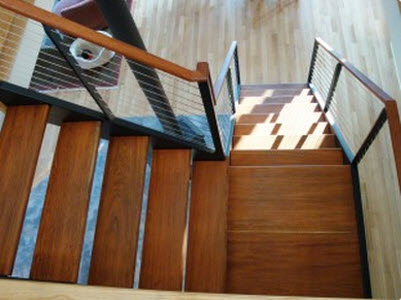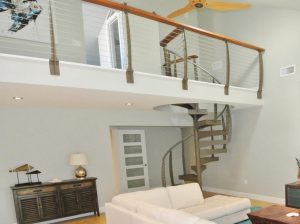Friday, 13 November 2015
Grade slab
In construction, a grade slab is a relatively flat concrete structure built on top of the soil at ground level. This simple slab design differs from the reinforced slab technique used for elevated concrete floors, and does not require support from underground footers or foundation walls. The grade acts as the foundation for a home or building, and provides a stable base for walls and other building elements.
TYPES OF FOUNDATIONS
Read our introduction to foundations if you have missed it.
In this article we will discuss the common types of foundations in buildings. Broadly speaking, all foundations are divided into two categories: shallow foundations and deep foundations. The words shallow and deep refer to the depth of soil in which the foundation is made. Shallow foundations can be made in depths of as little as 3ft (1m), while deep foundations can be made at depths of 60 - 200ft (20 - 65m). Shallow foundations are used for small, light buildings, while deep ones are for large, heavy buildings.
In this article we will discuss the common types of foundations in buildings. Broadly speaking, all foundations are divided into two categories: shallow foundations and deep foundations. The words shallow and deep refer to the depth of soil in which the foundation is made. Shallow foundations can be made in depths of as little as 3ft (1m), while deep foundations can be made at depths of 60 - 200ft (20 - 65m). Shallow foundations are used for small, light buildings, while deep ones are for large, heavy buildings.
SHALLOW FOUNDATIONS
Shallow foundations are also called spread footings or open footings. The 'open' refers to the fact that the foundations are made by first excavating all the earth till the bottom of the footing, and then constructing the footing. During the early stages of work, the entire footing is visible to the eye, and is therefore called an open foundation. The idea is that each footing takes the concentrated load of the column and spreads it out over a large area, so that the actual weight on the soil does not exceed the safe bearing capacity of the soil.
There are several kinds of shallow footings: individual footings, strip footings and raft foundations.
In cold climates, shallow foundations must be protected from freezing. This is because water in the soil around the foundation can freeze and expand, thereby damaging the foundation. These foundations should be built below the frost line, which is the level in the ground above which freezing occurs. If they cannot be built below the frost line, they should be protected by insulation: normally a little heat from the building will permeate into the soil and prevent freezing.
Shallow foundations are also called spread footings or open footings. The 'open' refers to the fact that the foundations are made by first excavating all the earth till the bottom of the footing, and then constructing the footing. During the early stages of work, the entire footing is visible to the eye, and is therefore called an open foundation. The idea is that each footing takes the concentrated load of the column and spreads it out over a large area, so that the actual weight on the soil does not exceed the safe bearing capacity of the soil.
There are several kinds of shallow footings: individual footings, strip footings and raft foundations. In cold climates, shallow foundations must be protected from freezing. This is because water in the soil around the foundation can freeze and expand, thereby damaging the foundation. These foundations should be built below the frost line, which is the level in the ground above which freezing occurs. If they cannot be built below the frost line, they should be protected by insulation: normally a little heat from the building will permeate into the soil and prevent freezing. |
INDIVIDUAL FOOTINGS
Individual footings are one of the most simple and common types of foundations. These are used when the load of the building is carried by columns. Usually, each column will have its own footing. The footing is just a square or rectangular pad of concrete on which the column sits. To get a very rough idea of the size of the footing, the engineer will take the total load on the column and divide it by the safe bearing capacity (SBC) of the soil. For example, if a column has a vertical load of 20T, and the SBC of the soil is 10T/m2, then the area of the footing will be 2m2. In practice, the designer will look at many other factors before preparing a construction design for the footing.
Individual footings are usually connected by a plinth beam, a horizontal beam that is built at ground or below ground level.
STRIP FOOTINGS
Strip footings are commonly found in load-bearing masonry construction, and act as a long strip that supports the weight of an entire wall. These are used where the building loads are carried by entire walls rather than isolated columns, such as in older buildings made of masonry.
RAFT OR MAT FOUNDATIONS
Raft Foundations, also called Mat Foundations, are most often used when basements are to be constructed. In a raft, the entire basement floor slab acts as the foundation; the weight of the building is spread evenly over the entire footprint of the building. It is called a raft because the building is like a vessel that 'floats' in a sea of soil.
Mat Foundations are used where the soil is week, and therefore building loads have to be spread over a large area, or where columns are closely spaced, which means that if individual footings were used, they would touch each other.
Mat Foundations are used where the soil is week, and therefore building loads have to be spread over a large area, or where columns are closely spaced, which means that if individual footings were used, they would touch each other.
DEEP FOUNDATIONS
PILE FOUNDATIONS
A pile is basically a long cylinder of a strong material such as concrete that is pushed into the ground so that structures can be supported on top of it.
Pile foundations are used in the following situations:
- When there is a layer of weak soil at the surface. This layer cannot support the weight of the building, so the loads of the building have to bypass this layer and be transferred to the layer of stronger soil or rock that is below the weak layer.
- When a building has very heavy, concentrated loads, such as in a high rise structure.
Pile foundations are capable of taking higher loads than spread footings.
There are two types of pile foundations, each of which works in its own way.
End Bearing Piles
In end bearing piles, the bottom end of the pile rests on a layer of especially strong soil or rock. The load of the building is transferred through the pile onto the strong layer. In a sense, this pile acts like a column. The key principle is that the bottom end rests on the surface which is the intersection of a weak and strong layer. The load therefore bypasses the weak layer and is safely transferred to the strong layer.
Friction Piles
Friction piles work on a different principle. The pile transfers the load of the building to the soil across the full height of the pile, by friction. In other words, the entire surface of the pile, which is cylindrical in shape, works to transfer the forces to the soil.
- When there is a layer of weak soil at the surface. This layer cannot support the weight of the building, so the loads of the building have to bypass this layer and be transferred to the layer of stronger soil or rock that is below the weak layer.
- When a building has very heavy, concentrated loads, such as in a high rise structure.
Pile foundations are capable of taking higher loads than spread footings.
There are two types of pile foundations, each of which works in its own way.
In end bearing piles, the bottom end of the pile rests on a layer of especially strong soil or rock. The load of the building is transferred through the pile onto the strong layer. In a sense, this pile acts like a column. The key principle is that the bottom end rests on the surface which is the intersection of a weak and strong layer. The load therefore bypasses the weak layer and is safely transferred to the strong layer.
Friction Piles
Friction piles work on a different principle. The pile transfers the load of the building to the soil across the full height of the pile, by friction. In other words, the entire surface of the pile, which is cylindrical in shape, works to transfer the forces to the soil.
Wednesday, 11 November 2015
Types of Stairs
When talking with customers regarding stairs and railings, it is helpful if we all use the same terminology. There are many types of stairs that we can build or add railings to. The following list describes some of the more popular stair types:
Straight Stairs
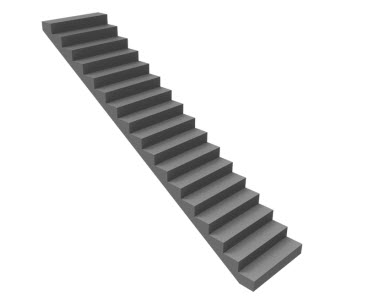
Straight Stairs
Straight stairs are certainly one of the most common types of stairs found in both residential and commercial properties.
Advantages of straight Stairs:
- Straight stairs tend to be the easiest to go up and down or ascend/descend as we say in the industry.
- They are typically the easiest to build however this depends allot on the level of detail in the design.
- Straight stairs only need to be connected at the top and the bottom (no intermediate supporting structure is required).
- They work well with minimalist designed homes due to their inherent simplicity.
- By selecting thinner treads, open risers and thin metal stringers, straight stairs can be made more transparent than other types of stairs allowing less obstruction to the view beyond.
- No landing is required if the number of risers are kept under 16 or the overall vertical height is less than 12 feet.
- Its relatively easy to build railings and handrails for straight stairs.
- Measuring for railings is simpler also.
Disadvantages of straight stairs:
- Straight stairs use up a fair amount of linear space which has to be planned for in your design.
- Some of the other stair types create a privacy barrier between the floors of your home. Straight stairs do not offer this privacy.
- A stair 12 feet high requires a landing to break up the span. The addition of a landing will use up allot more space and therefore these types of stairs are seldom used in residential construction. You will see these more frequently in large commercial buildings.
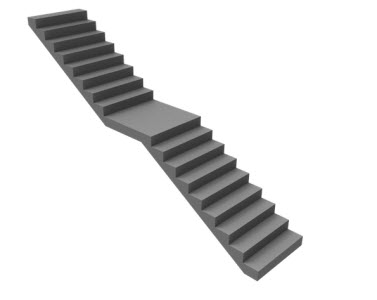
Straight Stair with central landing.
L Shaped Stair (or sometimes called quarter turn stairs)
The L shaped stair is a variation of the straight stair with a bend in some portion of the stair. This bend is usually achieved by adding a landing at the bend transition point. The bend is often 90 degrees, however it does not have to be. If the landing is closer to the top or bottom of the stairs it is sometimes referred to as a long L stair.

L Shaped Stair
Advantages of L shaped Stairs:
- L Stairs can be more visually interesting.
- They provide a visual barrier between floors so they can add some privacy.
- Also L Stairs can help somewhat with sound transmission between floors if the stairs are contained within walls.
- Some believe they are safer than straight stairs as the central landing reduces the number of treads one could fall in a given flight.
- The landing can provide a place to stop and rest while ascending.
- They can be located in a corner of a room if this works better for your design.
Disadvantages of L shaped Stairs:
- L shaped stairs are a bit more difficult to build.
- A support is typically required for the landing in a L type stair. Often this is built into the surrounding walls so it goes unnoticed. In modern dwellings however it is usually desirable to open up the space leaving the stair structure visible. In these cases the supporting structure can be visually minimized by taking advantage of the strength of steel to create slim supporting members. Through careful engineering,it is possible to eliminate the landing support all together.
- Handrails for these types of stairs require more skill and planning to construct.
- In climates where basements are used, stairs are typically stacked over each other for efficient use of space. Since basements are often used for storage, large items can be difficult to move in and out of the basement.
U shaped Stairs (or sometimes called half turn stairs or switchback stairs)
U Shaped stairs are basically 2 parallel flights of straight stairs joined by by a landing that requires 180 degree turn in the walk line. If a third flight is inserted into the middle of the stairs, it would become a double L stair (or quarter landing).
Advantages of U shaped Stairs:
- U shaped stairs can be easier to fit into an architectural plan.
- They offer some architectural interest.
- The landing(s) can offer a resting point part way up the stairs.
Disadvantages of U shaped Stairs:
- These types of stairs are a bit more difficult to build.
Winder Stairs
Winder stairs are a variation of an L shaped stair but instead of a flat landing, they have pie shaped or triangular steps at the corner transition.
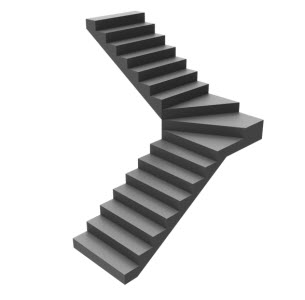
L Shaped Winder Stairs
Advantages of Winder Stairs:
- The main advantage of winder stairs is that they require less space than many other types of stairs. They are very common in older homes, often used as a secondary staircase where the grand staircase may have been in the entry and the winder used as a access to the kitchen.
- They have more visual interest. Winder stairs seem to create a more seamless transition,visually, as they meander around corners. For this reason they have gained popularity in modern homes. Their compactness has also made them attractive in sustainable home designs.
Disadvantages of Winder Stairs:
- Winder stairs are a little harder to navigate than L stairs.
- It can be more difficult to add a handrail to these than some of the other types of stairs.
- Like L shaped stairs, a center support is typically required.
Spiral Stairs
Spiral stairs are a often confused with curved stairs. Although, both types of stairs follow a helical arc (like the shape of a spring), spiral stairs usually are made very compact and the treads radiate around a center pole.
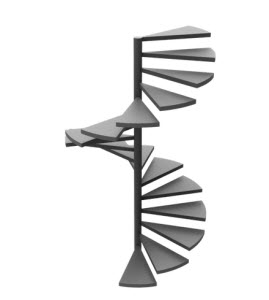
Spiral Stairs
Advantages of Spiral Stairs:
- One of the key advantages of spiral stairs is their compactness. They are very popular on beach front decks where space is at a premium. They are also used extensively on city lofts for the same reason.
- Spiral stairs can be attractive and there are may variations on railings styles which can have a major impact on the overall appearance of the stair.
- Since the center pole and landing typically provide the structural support for the stairs, they do not need much in the way of extra support structures making installation easier than many other types of stairs.
Disadvantages of Spiral Stairs:
- Spiral stairs are more difficult to navigate than other types of stairs. It is for this reason that codes do not allow them to be used as the primary access to a full second floor of a home. Walk ability improves as the outside diameter gets larger so if you have the space, you may want to consider going a bit larger. We recommend going 5 feet in diameter if you can.
- It is difficult to carry large items up spiral stairs.
- Only one person can go up or down the stairs at the same time.
Curved Stairs
Curved stairs add elegance to home or business. For this reason they are almost always located at the entry where it makes the best first impression. Curved stairs, like spiral stairs are helical however, they tend to be on a much larger radius and typically do not make a full circle.
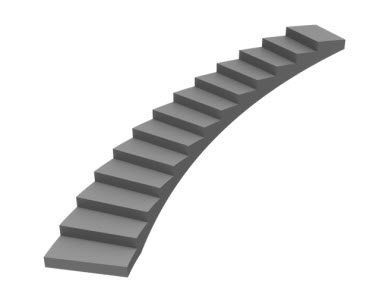
Curved Staircase
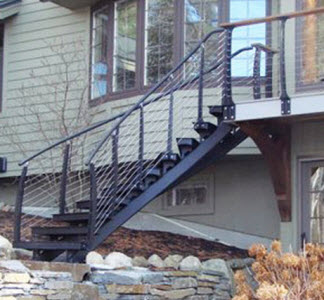
Example Curved Stairs
Advantages of Curved Stairs:
- Curved staircases are often very elegant and traditional but this type of design can equally be adapted to contemporary designs.
- They are relatively easy to walk up (if the radius is large).
Disadvantages of Curved Stairs:
- Curved stairs are by far the most difficult to build of the various types of stairs. In fact building curved stairs represents a pinnacle of achievement for any stair builder or fabricator. For this reason, they are the most costly to build.
Ladders
Since the definition of a stair is a series of steps leading from one floor to another, we would be remiss if we did not include ladders. Library ladders or loft ladders are becoming more popular to conserve space in smaller, sustainable designs.

Library Ladder
Advantages of Ladders:
- The most compact way to get from one floor to another.
- Very cost effective due to their simple design.
- Can have wheels or fold up to move them out of the way when not in use or to prevent access.
- Can be used to access shelves that would be to high too reach normally.
Disadvantages of Ladders:
- Ladders are the most difficult to climb, especially while descending.
- Can not be used as a primary staircase.
Subscribe to:
Comments (Atom)





